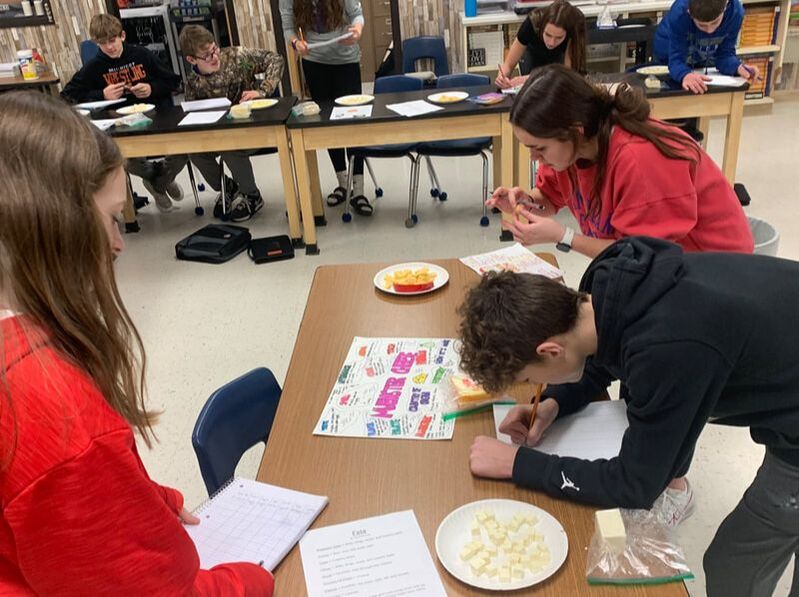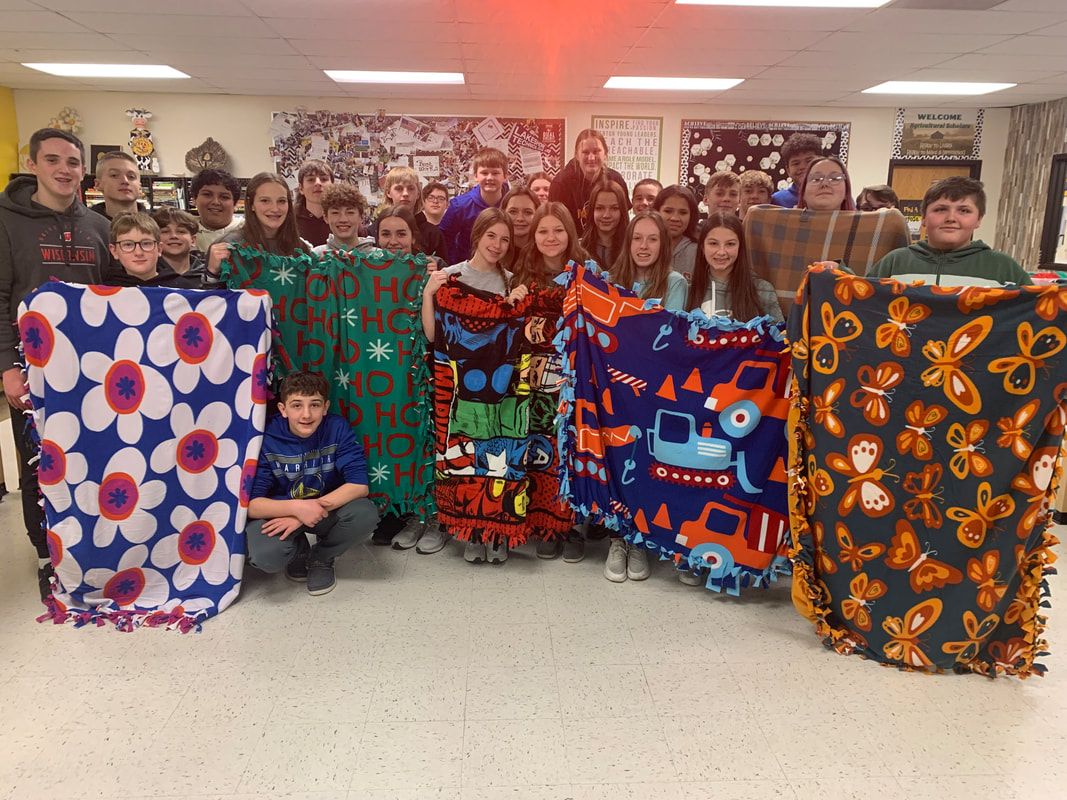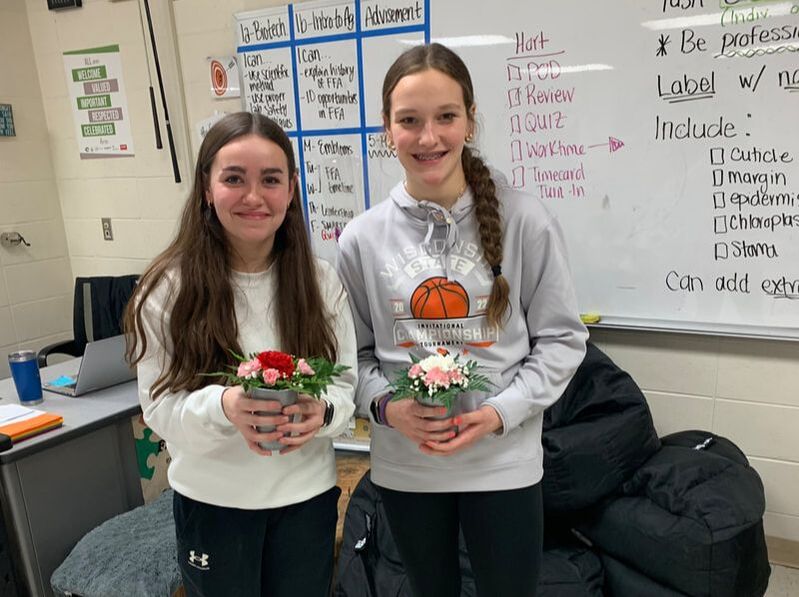Middle School Ag 8
On-Going Resources
Daily Smart Starts (GSlides). SAE Project (GDoc). SAE Rubric (GDoc).
Zoom: Virtual Learning Zoom Room (Link).
Week One - 9/5-9/8 - Agriculture, FFA, SAE - The Three Circle Model
Tu: I can name all classmates by first and last name
Week Two - 9/12-9/15 - Ag Mechanics - Power, Structural and Technical Pathway
M: I can explain what FFA does on a local, state, and national level.
Week Three - 9/18-9/22 - Food Science, Products & Processing Pathway
M: I can explain the farm to fork model for cheese.
Week Four - 9/25-9/29 - Plant & Soil Science Pathway
M & Tu: I can use the scientific method & engineering process to grow radishes.
Week Five - 10/2-10/6 - Natural Resource Pathway
M: I can identify WI renewable and nonrenewable resources.
Week Six - 10/9-10/13 - Wildlife and Environmental Science Pathway
M: I can compare and contrast abiotic & biotic environmental factors
Week Seven- 10/16-10/19 - Animal Science Pathway
M: I can examine historical and future developments in animal science.
Week Eight - 10/23-10/27 - Biotechnology Pathway
M-Tu: I can explain eye parts and functions.
Week Nine - 10/30-11/3 - Communications Pathway
November 6th/7th - FINAL TEST
Older Resources:
InstAGram template (PDF).
Pumpkin Design LAB (GDoc).
Applying Heredity Concepts In this lesson, students will complete monohybrid and dihybrid Punnett squares in preparation for taking on a challenge to breed cotton plants that produce naturally blue colored cotton. Grades 6-8
Can We Have Too Much of a Good Thing? In this lesson students will understand that plants require nutrients in the proper concentrations. Students will discover that plants can be damaged or killed by either too many or too few nutrients. Grades 6-8
Cotton's American Journey (Grades 6-8) Students investigate the impact of cotton on the history and culture of the United States. Students will discover the growth and processing requirements for cotton, recognize how the invention of the cotton gin affected slavery, explain how the plantation system was organized, and ultimately understand the role of cotton in the Civil War. Grades 6-8
Hen House Engineering (Grades 6-8) Students will use the Claim, Evidence, and Reasoning model to evaluate styles of housing used for hens that lay eggs. Using critical thinking skills, students will compare housing styles, determine which system meets their animal welfare standards, and engineer their own hen house model to meet the needs of laying hens. This lesson covers a socioscientific issue and aims to provide students with tools to evaluate science within the context of social and economic points of view. Grades 6-8
Daily Smart Starts (GSlides). SAE Project (GDoc). SAE Rubric (GDoc).
Zoom: Virtual Learning Zoom Room (Link).
Week One - 9/5-9/8 - Agriculture, FFA, SAE - The Three Circle Model
Tu: I can name all classmates by first and last name
- Fill out & return signed permission form (GDoc).
- Create a personal InstAGram for your teacher to get to know you and submit (GSlides).
- In class discussion - MS - Back to School Expectations (GSlide).
- Take notes as a class on the 8 Pathways of agriculture (GSlides).
- With your group complete an Ag Commodity Poster (Link) and be ready to share tomorrow.
- Take the Ag Career Explorer (Link) test in class, discuss in class and reflect.
- OPTIONAL Career task (GDoc) and/or make up work if you miss class discussion.
- Perform FFA scavenger hunt in class using the following links. National FFA Website (Link). Wisconsin FFA Website (Link). Mishicot FFA Website (Link).
Week Two - 9/12-9/15 - Ag Mechanics - Power, Structural and Technical Pathway
M: I can explain what FFA does on a local, state, and national level.
- Participate in all activities our Section 9 State FFA Officer has for us during class.
- Discuss the importance of service learning in class and create tie blankets to donate to Project Linus (Link).
- Discuss Tool ID & Safety. Tool ID (GSlides).
- In class lab Hypertufa Inquiry Lab (GDoc).
Week Three - 9/18-9/22 - Food Science, Products & Processing Pathway
M: I can explain the farm to fork model for cheese.
- Watch Art of Cheesemaking Video (Link) and take notes.
- Take notes on Intro Notes (GSlides).
- In your team complete intro worksheet (GDoc).
- Select a cheese variety slips (GDoc). to research following the research requirements (GDoc) using Wisconsin cheese (Link) and other sites to research.
- Present and prepare your cheese & information to perform sensory analysis. sensory chart (GDoc).
Week Four - 9/25-9/29 - Plant & Soil Science Pathway
M & Tu: I can use the scientific method & engineering process to grow radishes.
- In a group work on your radish races packet (GDoc).
- Complete slides in class - Floral Basics Powerpoint (GSlides).
- Floral lab in class. Design rubric (Doc).
- Perform a lab using soybeans in class or at home, be ready to reflect on your success or lack of. Soybeans. Lab Options - Crayons (GDoc). Candles (GDoc). Lip Balm (GDoc). Hand Cream (GDoc). Emlusion (GDoc).
Week Five - 10/2-10/6 - Natural Resource Pathway
M: I can identify WI renewable and nonrenewable resources.
- In teams complete vocabulary collage (GDoc).
- As a class discuss into slides (GSlides) and take notes.
- In class research document (GDoc).
- Lab day on MECCA.
Week Six - 10/9-10/13 - Wildlife and Environmental Science Pathway
M: I can compare and contrast abiotic & biotic environmental factors
- Take notes on intro slides (GSlides).
- In class discussion and Oh Deer Activity (Link).
- Lab day on MECCA
- In class lab. MECCA Nature Walk Document (GDoc). Flora & Fauna in the School Forest Document (GSlides).
Week Seven- 10/16-10/19 - Animal Science Pathway
M: I can examine historical and future developments in animal science.
- Take Intro Notes (GSlides). and and be ready to discuss .
- Work in teams through Lesson Plan (Link). Biomimicry (Link).
- Read through and be ready to discuss.
Week Eight - 10/23-10/27 - Biotechnology Pathway
M-Tu: I can explain eye parts and functions.
- Perform in class sheep eye dissection. Notes (PDF)
- Read through What is DNA Reading (Link).
- Perform in class lab or if virtual complete DNA Home Lab (GDoc). Lab Example Video (Link).
- Watch Ag Advancements Video and compare and contrast two ag technologies via an infographic. Link to FFA Lessons (Link).
Week Nine - 10/30-11/3 - Communications Pathway
- M: I can ID 5 local and 5 international agribusinesses.
- Research tools - Agribusiness Research Steps (GDoc). Local Agribusiness Examples (GDoc).
- Tu: I can examine company goals/objectives.
- In class discussion and mafia activity (Link).
- W-Th: I can advocate for agriculture using professionalism.
- In class activity - tools - Advocacy Links from FFA Lessons (Link). Gallery Walk of Agribusinesses (GDoc). Reflection (GDoc).
- F: I can reflect on my future in agriculture.
- Complete class reflection - Class Reflection. Reflection (GForms).
- F: REVIEW
November 6th/7th - FINAL TEST
Older Resources:
InstAGram template (PDF).
Pumpkin Design LAB (GDoc).
Applying Heredity Concepts In this lesson, students will complete monohybrid and dihybrid Punnett squares in preparation for taking on a challenge to breed cotton plants that produce naturally blue colored cotton. Grades 6-8
Can We Have Too Much of a Good Thing? In this lesson students will understand that plants require nutrients in the proper concentrations. Students will discover that plants can be damaged or killed by either too many or too few nutrients. Grades 6-8
Cotton's American Journey (Grades 6-8) Students investigate the impact of cotton on the history and culture of the United States. Students will discover the growth and processing requirements for cotton, recognize how the invention of the cotton gin affected slavery, explain how the plantation system was organized, and ultimately understand the role of cotton in the Civil War. Grades 6-8
Hen House Engineering (Grades 6-8) Students will use the Claim, Evidence, and Reasoning model to evaluate styles of housing used for hens that lay eggs. Using critical thinking skills, students will compare housing styles, determine which system meets their animal welfare standards, and engineer their own hen house model to meet the needs of laying hens. This lesson covers a socioscientific issue and aims to provide students with tools to evaluate science within the context of social and economic points of view. Grades 6-8


